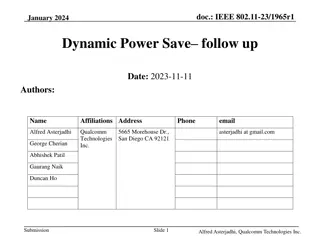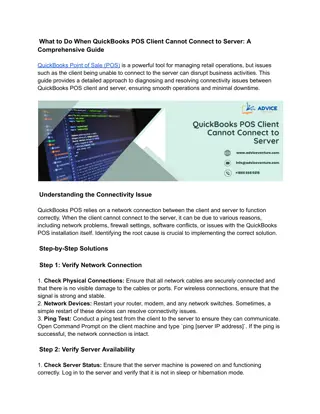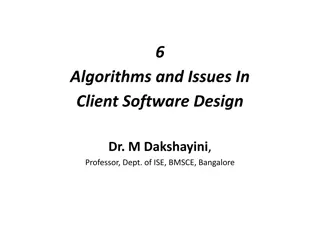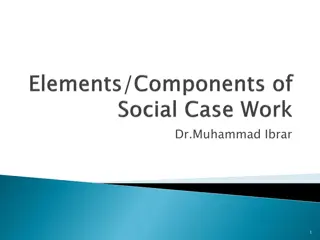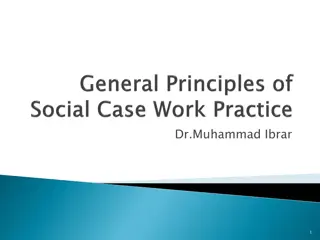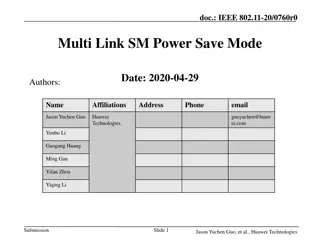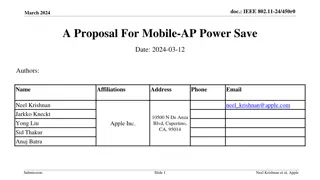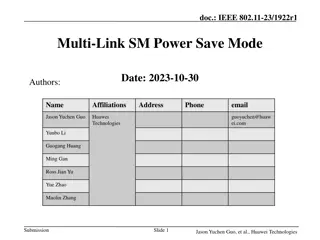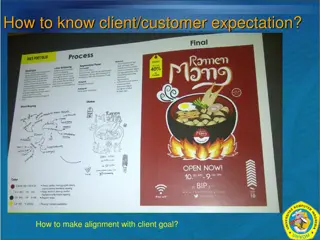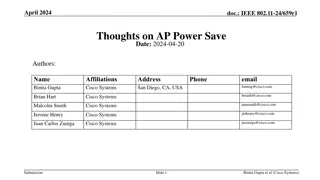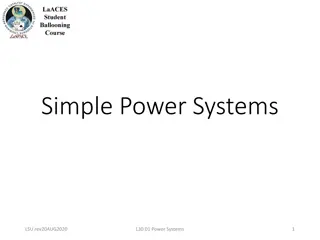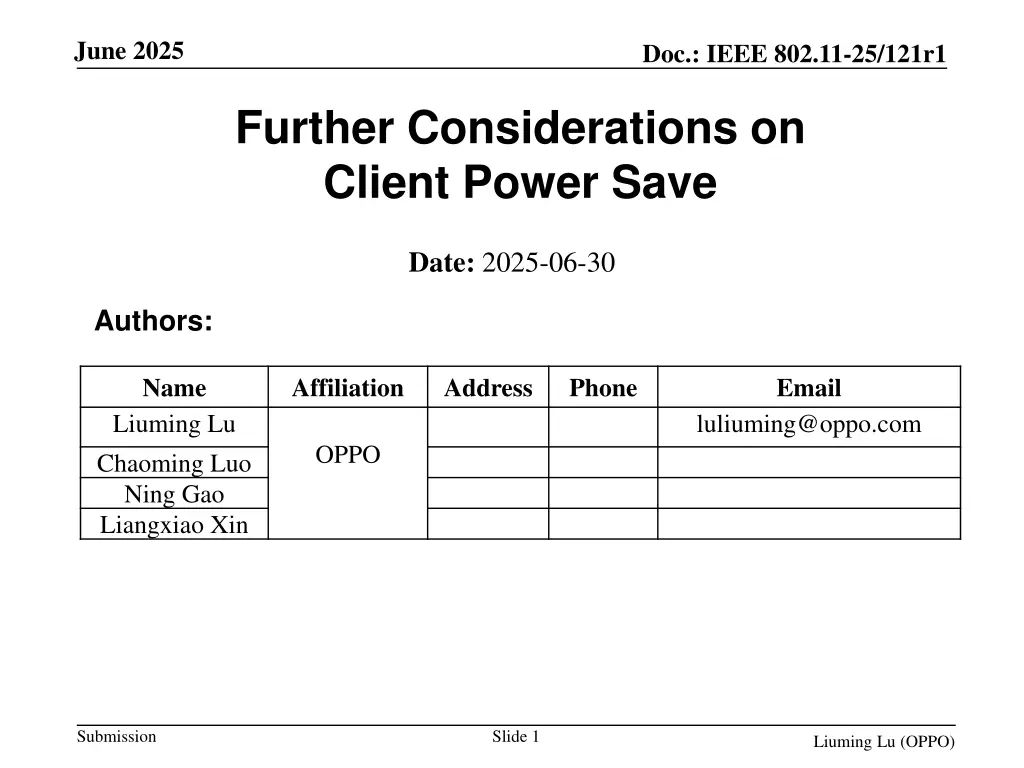
Client Power Save Mechanism in IEEE 802.11-25
Exploring the importance of power save mechanisms for client devices in IEEE 802.11-25 standard. Discusses cross-link PM mode signaling and DPS mode for efficient power management. Analyzes issues and proposes solutions for enhanced efficiency.
Download Presentation

Please find below an Image/Link to download the presentation.
The content on the website is provided AS IS for your information and personal use only. It may not be sold, licensed, or shared on other websites without obtaining consent from the author. If you encounter any issues during the download, it is possible that the publisher has removed the file from their server.
You are allowed to download the files provided on this website for personal or commercial use, subject to the condition that they are used lawfully. All files are the property of their respective owners.
The content on the website is provided AS IS for your information and personal use only. It may not be sold, licensed, or shared on other websites without obtaining consent from the author.
E N D
Presentation Transcript
June 2025 Doc.: IEEE 802.11-25/121r1 Further Considerations on Client Power Save Date: 2025-06-30 Authors: Name Liuming Lu Chaoming Luo Ning Gao Liangxiao Xin Affiliation Address Phone Email luliuming@oppo.com OPPO Submission Slide 1 Liuming Lu (OPPO)
June 2025 Doc.: IEEE 802.11-25/121r1 Introduction Power save is very important especially for client devices such as mobile phones. Currently 802.11bn task group has agreed to define cross link PM mode signaling mechanism and DPS mode . cross link PM mode signaling mechanism Allowing a non-AP MLD to indicate to its associated AP MLD that supports the mechanism, in a frame sent on one enabled link, the power management mode for one or more of its affiliated non-AP STAs Whether support for the mechanism is mandatory or optional is TBD Dynamic Power Save DPS mode the STA that uses DPS mode may transition from a lower capability (LC) mode to a higher capability (HC) mode upon reception of an initial control frame This contribution analyzes the issues needed to be resolved for cross link PM mode signaling mechanism and gives some proposals. Submission Slide 2 Liuming Lu (OPPO)
June 2025 Doc.: IEEE 802.11-25/121r1 Recap Power management - baseline Non-AP STA can be in one of two power management modes: 1. Active mode: The STA receives and transmits frames at any time if the STA is in awake state. A non-HE STA remains in the awake state. An HE STA remains in the awake state, unless the STA is unavailable. 2. Power save (PS) mode: The STA enters the awake state to receive or transmit frames. The STA remains in the doze state otherwise. STA in PS mode can be in one of two power states: Awake: STA is fully powered. Doze: STA is not able to transmit or receive non-WUR PPDUs and consumes very low power. ML power-save operation in EHT Each non-AP STA affiliated with a non-AP MLD that is operating on an enabled link shall maintain its own power management mode and power states. Frame exchanges on an enabled link are possible when the non-AP STA affiliated with the non-AP MLD operating on that link is in the awake state Submission Slide 3 Liuming Lu (OPPO)
June 2025 Doc.: IEEE 802.11-25/121r1 Extended PM modes in UHR Power management - UHR Non-AP STA can be in one of three power management modes: 1. Active mode: The STA receives and transmits frames at any time if the STA is in awake state. A non-HE STA remains in the awake state. An HE STA remains in the awake state, unless the STA is unavailable. Awake: STA is fully powered 2. Power save (PS) mode: The STA enters the awake state to receive or transmit frames. The STA remains in the doze state otherwise. A STA in PS mode can be in one of two power states: Awake: STA is fully powered. Doze: STA is not able to transmit or receive non-WUR PPDUs and consumes very low power. 3. DPS mode: The STA receives and transmits frames at any time if the STA is in awake state. An UHR STA remains in the awake state, unless the STA is unavailable. Awake: STA operates in lower capability (LC) mode and to transition to higher capability (HC) mode upon reception of an ICF transmitted by its associated DPS assisting STA Submission Slide 4 Liuming Lu (OPPO)
June 2025 Doc.: IEEE 802.11-25/121r1 Issues for cross link PM mode signaling 1. Three power management modes including active mode, PS mode, DPS mode need to be considered for cross link PM mode signaling 2. The following factors should be taken into account when considering the expected effective time that the STA enters into target power management mode indicated by cross link PM mode signaling : the STA corresponding to the indicated link needs to enter into target power management mode as soon as possible. Enough time needs to be reserved for AP corresponding to indicated link to make it get ready for serving the STA of the indicated link for its target power management mode as there exists potential cross-link signaling delay 3. The actual effective time for the indicated STA to enter into target PM mode may be different from the expected effective time. For example, the indicated STA to enter into PS mode may still do frame exchanges when the expected effective time arrive. To resolve this inconsistent issue, special rules need to be specified. Submission Slide 5 Liuming Lu (OPPO)
June 2025 Doc.: IEEE 802.11-25/121r1 Proposal 1: Cross link signaling for power save should support the indications for three PM modes Cross link signaling for three PM modes A STA affiliated with a MLD can indicate that the other STA that is affiliated with the same MLD will enter into the target PM mode that may be active mode, PS mode, DPS mode. 1. The indicated STA will transition from one PM mode to another PM mode within the three PM modes Current PM mode Target PM mode Active mode Active mode PS mode PS mode DPS mode DPS mode 2. The indicated STA will also transition from one DPS mode to the other DPS mode as there may exist DPS modes with different Rx/Tx parameters for their LC modes and/or HC modes Target PM mode Current PM mode DPS mode 2 DPS mode 1 LC mode (40 MHz BW, 1 SS HC mode (80 MHz BW, 2 SS) LC mode (20 MHz BW, 1 SS HC mode (80 MHz BW, 1 SS) Submission Slide 6 Liuming Lu (OPPO)
June 2025 Doc.: IEEE 802.11-25/121r1 Proposal 2: the transition timeout is introduced for cross link PM mode signaling The Transition timeout for the indicated PM mode is introduced by considering cross-link signaling delay to make the associated AP get ready for serving the STA the indicated STA may enter into target PM mode, either: a) At the end of the transition timeout interval, or b) Before the end of the transition timeout interval, immediately after transmitting an acknowledgment as a response to the received ML PM mode indication notification frame from one of the APs affiliated with the AP MLD. whichever comes first. transition transition timeout expires timeout expires Time Time transition timeout for transition timeout for ML PM mode indication ML PM mode indication STA1 enters into DPS mode STA1:transition from active transition from active mode to the DPS mode mode to the DPS mode ML PM mode ML PM mode indication indication notification notification Non-AP STA 1 AP 1 Link 1 Link 1 Beacon Beacon ACK ACK ACK ACK Non-AP STA 2 Link 2 AP 2 Link 2 ML PM mode ML PM mode indication indication notification notification transition timeout for ML PM mode indication transition timeout for ML PM mode indication AP MLD Non-AP MLD STA1:transition from active mode to the DPS mode STA1:transition from active mode to the DPS mode Submission Slide 7 Liuming Lu (OPPO)
June 2025 Doc.: IEEE 802.11-25/121r1 Proposal 3: special rules are specified to resolve the inconsistency issue for cross link PM mode signaling The AP with which the indicated STA is associated may still keep sending DL traffic to the STA after the ML PM mode indication that the STA will enter into PS mode has been sent. In such case, a special rule can be considered to be specified, e.g. : If the indicated STA to enter into target PM mode still do frame exchanges that include no ML PM mode indication when the expected effective time arrives (e.g. the transition timeout expires) the STA will enter into the target PM mode after the end of the frame exchanges. transition transition timeout expires timeout expires Time Time STA1 enters into PS mode Non-AP STA 1 Data frames Data frames Data frames Data frames AP 1 Link 1 Link 1 BA BA BA BA transition timeout for transition timeout for ML PM mode indication ML PM mode indication Frame exchanges that include no ML PM mode indication ACK ACK Non-AP STA 2 Link 2 AP 2 Link 2 ML PM mode ML PM mode indication indication notification notification transition timeout transition timeout for ML PM mode indication for ML PM mode indication Beacon Beacon AP MLD Non-AP MLD STA1:transition from active mode to the PS mode STA1:transition from active mode to the PS mode Submission Slide 8 Liuming Lu (OPPO)
June 2025 Doc.: IEEE 802.11-25/121r1 Summary There exist issues needed to be solved for cross link PM mode signaling. This contribution analyzes the issues and proposes that: Cross link signaling for power save should support the indications for three PM modes the transition timeout is introduced for cross link PM mode signaling special rules are specified to resolve the inconsistency issue for cross link PM mode signaling Submission Slide 9 Liuming Lu (OPPO)
June 2025 Doc.: IEEE 802.11-25/121r1 References [1] tgbn-motions-list-part-2, https://mentor.ieee.org/802.11/dcn/25/11-25-0014-16-00bn-tgbn-motions- list-part-2.pptx [2] tgbn-motions-list-part-1, https://mentor.ieee.org/802.11/dcn/24/11-24-0171-26-00bn-tgbn-motions- list-part-1.pptx [3] Power Save Protocols for UHR - follow up, https://mentor.ieee.org/802.11/dcn/24/11-24-0544-01- 00bn-power-save-protocols-for-uhr-follow-up.pptx [4] Client power save, https://mentor.ieee.org/802.11/dcn/23/11-23-2003-00-00bn-client-power- save.pptx [5] Multi link Power Management for MLO, https://mentor.ieee.org/802.11/dcn/24/11-24-0602-00-00bn- multi-link-power-management-for-mlo.pptx Submission Slide 10 Liuming Lu (OPPO)
June 2025 Doc.: IEEE 802.11-25/121r1 SP1 SP 1: Do you agree that the cross link PM mode signaling mechanism to be specified should support the signaling for power management modes including active mode, PS mode, DPS mode in UHR? The mechanism is TBD. Submission Slide 11 Liuming Lu (OPPO)
June 2025 Doc.: IEEE 802.11-25/121r1 SP2 SP 2: Do you agree that the transition timeout for the indicated STA to enter into the target PM mode is defined by considering cross-link signaling delay to make the associated AP get ready for serving the STA for its target PM mode by cross link PM mode signaling mechanism? Submission Slide 12 Liuming Lu (OPPO)
June 2025 Doc.: IEEE 802.11-25/121r1 SP3 SP 3: Do you agree that the following rule is specified to resolve the inconsistency issue If the indicated STA to enter into target PM mode still do frame exchanges that include no ML PM mode indication when the expected effective time arrives (e.g. the transition timeout expires) the STA will enter into the target PM mode after the end of the frame exchanges. Submission Slide 13 Liuming Lu (OPPO)


